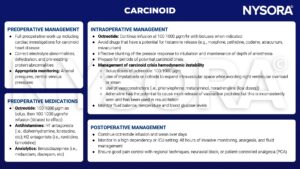Learning objectives
- Describe carcinoid and carcinoid syndrome
- Recognize the symptoms and signs of carcinoid and carcinoid syndrome
- Anesthetic management of a patient with carcinoid
Definition and mechanisms
- A carcinoid is a slow-growing neuroendocrine tumor derived from enterochromaffin or Kulchitsky cells
- Carcinoid tumors usually begin in the gastrointestinal tract (i.e., stomach, appendix, small intestine, colon, or rectum), or in the lungs
- Carcinoid syndrome (± 20% of patients with carcinoid tumors) results from the direct release of vasoactive amines (e.g., serotonin and histamine) and peptides into the systemic circulation, usually from hepatic metastases associated with midgut (jejunum, ileum, appendix, and cecum) carcinoids
Signs and symptoms
Some tumors do not cause any signs or symptoms. When they do occur, signs and symptoms are usually vague and depend on the tumor’s location.
| Location | Signs and symptoms |
|---|---|
| Gastrointestinal tract | Abdominal pain Diarrhea Nausea, vomiting, and bowel obstruction Rectal bleeding Rectal pain Skin flushing |
| Lungs | Chest pain Wheezing Dyspnea Diarrhea Skin flushing Weight gain Pink or purple marks on the skin (looking like stretch marks) |
Clinical manifestations of carcinoid syndrome
| Sign/symptom | Frequency | Characteristics | Involved mediators |
|---|---|---|---|
| Flushing | 85-90% | Foregut: long-lasting purple face and neck Midgut: short-lasting, pink/red Severe flushing associated with hypotension and tachycardia | Kallikrein, 5-hydroxytryptophan(5-HTP; chemical precursor and metabolic intermediate in the biosynthesis of serotonin), histamine, substance P, prostaglandins (PGs) |
| GI hypermotility | 70-80% | Secretory diarrhea, nausea, vomiting | Gastrin, 5-HTP, histamine, PGs, vasoactive intestinal peptides (VIPs) |
| Abdominal pain | 35% | Progressive | Small bowel obstruction, hepatomegaly, ischemia |
| Right-sided heart failure | 30% | Dyspnea | 5-HTP, substance P |
| Left-sided heart failure | 10% | Dyspnea | 5-HTP, substance P |
| Telangiectasia | 25% | Face | Unknown |
| Bronchospasm | 15% | Wheezing | Histamine, 5-HTP |
| Pellagra | 5% | Dermatitis, diarrhea, dementia | Niacin deficiency |
Risk factors
- Age: Older adults
- Sex: Female gender
- Family history: History of multiple endocrine neoplasia, type 1 (MEN 1)
Complications
The cells of carcinoid tumors can secrete hormones and other chemicals, causing a range of complications including:
- Carcinoid syndrome: Causes skin flushing, chronic diarrhea, and difficulty breathing (i.e., bronchospasm), among other signs and symptoms (see table above)
- Carcinoid heart disease: Carcinoid tumors may secrete hormones causing thickening of the endocardium of the cardiac chambers, valves, and blood vessels, leading to leaky heart valves and heart failure (i.e., typically right-sided heart failure)
- Other endocrine disorders: Carcinoid tumors can also secrete growth hormone and adrenocorticotropin-releasing hormone, respectively leading to acromegaly and Cushing’s syndrome
Treatment
- Surgery: When detected early, possible to dissect completely
- Medications: To block the excess hormone secretion by the tumor and reduce the signs and symptoms, and slow tumor growth
- Chemotherapy: Recommended for advanced tumors that cannot be removed surgically
- Targeted drug therapy: Usually combined with chemotherapy for advanced tumors
- Treatment for tumors with metastases to the liver: Surgery to remove part of the liver, hepatic artery embolization (blocking blood flow to the liver), and using heat (i.e., radiofrequency ablation) and/or cold (i.e., cryoablation) to kill cancer cells
Management

Keep in mind
- The goal is to prevent, recognize, and treat perioperative carcinoid crises
- Triggers include histamine-releasing drugs, vasoactive drugs, succinylcholine; tumor manipulation; and hypovolemia, hypoxia, hypothermia, hypercarbia
- Treatment of perioperative bronchospasms include octreotide, steroids, histamine blockade (diphenhydramine), and Atrovent
- Avoid beta-agonists, theophylline, and epinephrine to treat perioperative bronchospasms
Suggested reading
- Kaltsas G, Caplin M, Davies P, et al. ENETS Consensus Guidelines for the Standards of Care in Neuroendocrine Tumors: Pre- and Perioperative Therapy in Patients with Neuroendocrine Tumors. Neuroendocrinology. 2017;105(3):245-254.
- Powell B, Al Mukhtar A, Mills GH. Carcinoid: the disease and its implications for anaesthesia. Continuing Education in Anaesthesia Critical Care & Pain. 2011;11(1):9-13.
- Mancuso K, Kaye AD, Boudreaux JP, et al. Carcinoid syndrome and perioperative anesthetic considerations. J Clin Anesth. 2011;23(4):329-341.
We would love to hear from you. If you should detect any errors, email us customerservice@nysora.com

